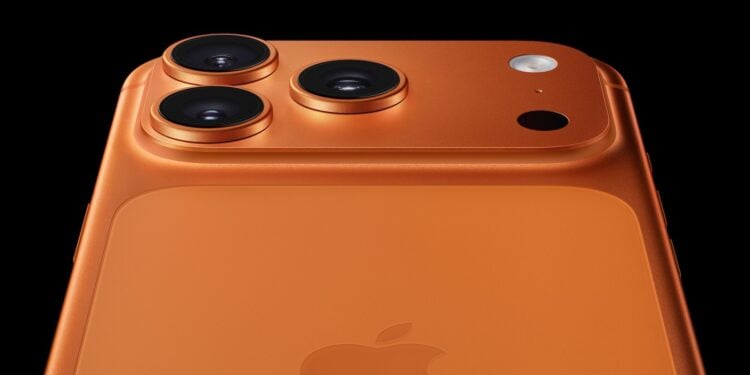With the iPhone 17, Apple is launching a new generation of its in-house chips. The A19 and A19 Pro form the basis of the various models, which differ in performance, features, and cooling. The decisive factor is how noticeable the differences between the chips are in everyday use.
Apple aims to significantly improve the performance of its devices with each new iPhone series. With the iPhone 17, this progress is particularly evident in the chips. Both the A19 and A19 Pro are based on an advanced 3-nanometer process and offer significant improvements in CPU, GPU, and artificial intelligence. However, not every chip is the same—and there are subtle but important differences depending on the model.
A19 in the iPhone 17
The standard iPhone 17 model is equipped with the A19. The chip offers a six-core CPU and a five-core GPU, delivering solid performance for everyday applications, games, and AI-powered features. Each GPU core is supported by a Neural Accelerator specifically designed to accelerate workflows and improve the performance of local AI models like Siri directly on the device. Additionally, the A19 features an updated 16-core Neural Engine, a redesigned display engine, and a new image signal processor.
A19 Pro in the iPhone Air
The iPhone Air also uses the A19 Pro, but in a version with a 6-core CPU and 5-core GPU. This means graphics performance remains similar to the A19, but the architecture of the Pro chip offers advantages. These include a 50 percent larger last-level cache, improved front-end bandwidth, and optimized branch prediction. The neural accelerators also benefit from the upgrades, delivering significantly higher computing performance than the previous chip, the A18 Pro.
A19 Pro in the iPhone 17 Pro and Pro Max
The real peak performance is found in the iPhone 17 Pro models. The A19 Pro features a 6-core CPU and a 6-core GPU. Apple calls it the fastest CPU in a smartphone and the most advanced GPU yet. In addition to the increased processing speed, the GPU offers unified image compression and second-generation dynamic caching. Another difference lies in the thermal architecture. The Pro models rely on vapor chamber cooling, which better controls heat generation and enables consistent performance. Combined with the architectural upgrades, this results in 40 percent better sustained performance compared to the A18 Pro in the iPhone 16 series.
AI performance and neural accelerators
The advancement is particularly evident in AI performance. The neural accelerators in the A19 Pro achieve four times the peak computing power of the A18 Pro. This allows complex tasks like image processing or speech processing to be completed significantly faster and more efficiently. Local AI models run more stably and faster, without the need for a cloud connection.
Differences in RAM
There are also clear differences in RAM within the iPhone 17 series. The iPhone 17 comes with 8 GB of RAM, while the iPhone Air and Pro models each have 12 GB. This is especially noticeable when multitasking and running memory-intensive applications, which run more smoothly on the Pro models and the Air.
A19 Pro in the iPhone 17 Pro: Apple's most powerful chip yet
The differences between the A19 and A19 Pro are particularly noticeable in the Pro models. While the A19 in the iPhone 17 offers solid and efficient performance for everyday use, the A19 Pro significantly improves in the versions for the iPhone Air and the Pro models. The iPhone 17 Pro and Pro Max, in particular, benefit from the more powerful GPU, improved architecture, and new vapor chamber cooling. Combined with more RAM and expanded AI performance capabilities, the iPhone 17 Pro is positioned as the most powerful device in the series. The best products for you: Our Amazon Storefront offers a wide selection of accessories, including those for HomeKit. (Image: Apple)
- iPhone Air weight: Comparison of all current Apple models
- iPhone 17: Apple brings significantly longer battery life
- iPhone 17: Apple introduces groundbreaking security feature
- iPhone 17: Dual Capture Video now directly in the Camera app
- macOS 26 brings repair assistant for calibration & parts
- iPhone Air with C1X modem – faster, more efficient, better
- iPhone 17 Pro uses aluminum – all the reasons in detail
- iPhone 17: N1 chip, more RAM and battery life at a glance
- High blood pressure warnings coming to older Apple Watch models
- AirPods Pro 2 and AirPods 4 get live translation feature
- MagSafe battery exclusively for iPhone Air – iPhone 17 runs out of power
- New iPhone accessories 2025: cases, bumpers and crossbody
- Final Cut Camera 2.0: All new features at a glance
- iPhone Air battery life: Comparison with iPhone 17 and predecessors
- iPhone 17: There is no longer a SIM slot in these countries
- Apple Watch Series 11: All new features at a glance
- iPhone 17 Pro: New design, A19 Pro chip and 8x zoom
- iPhone Air: The thinnest iPhone with all-day battery life
- iPhone 17 with Center Stage camera and A19 chip introduced
- Apple Watch SE 3 unveiled: Price, features, and availability
- Apple Watch Ultra 3: Innovation meets sustainability
- AirPods Pro 3: Apple's new top model for wireless audio





